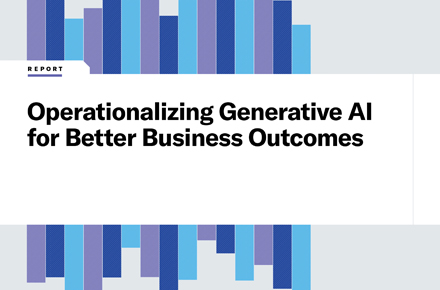7 vital steps to build an effective integration solution strategy
febrero 9, 2023 / Madhukar Govindiah | Venkat Viswanathan
Short on time? Read the key takeaways:
- Organizations are modernizing their IT stacks to drive business growth, often leading to a mix of interconnected custom-defined/home-grown applications and niche SaaS/COTS solutions.
- To achieve improved data-sharing, better information exchange and seamless business operations, disparate applications and systems must exchange data securely, automatically and friction-free.
- Seven steps to establish an effective integration solution strategy include linking integration to business outcomes, identifying typical scenarios, evaluating existing and new system integrations, understanding applicable interoperability standards, investing in an integration platform, ensuring the integration solution is well-architected and fostering a culture of integration.
- Organizations should evaluate integration platforms against specific requirements, including typical integration scenarios, existing and new interfaces, on-premises-to-cloud communication needs, security and data privacy considerations.
With the vision of driving business growth, organizations are transforming legacy software systems to modernize their IT stacks and achieve greater agility, scalability and cost savings.
This pursuit often leads to a mix of interconnected custom-defined/home-grown applications and niche software-as-a-service (SaaS)/commercial off-the-shelf (COTS) solutions to achieve their business objectives.
When these interconnected systems are integrated effectively, organizations experience improved data-sharing, better inter/intra-organization information exchange and seamless business operations. To achieve these results, disparate applications and systems must exchange data securely, automatically and friction-free. Here are seven vital steps to establish an effective integration solution strategy.
Step #1: Link integration to business outcomes
Integration is not just about technology transformation; it aims to drive positive business outcomes. When developing your integration initiative, consider the impact on consumption-based billing, compliance with applicable standards and regulations, enhanced security posture, statutory reporting needs, higher ROI, improved IT and operational technology (OT) interoperability, enhanced business agility or decreased risk of failure. To include business outcomes as part of your integration solution strategy:
- Quantify desired outcomes in business terms
- Set integration goals
- Measure meticulously
- Align solutions to specified outcomes
- Validate results on an ongoing basis
Step #2: Identify typical scenarios
Prepare and respond to current and future business and technical challenges by identifying the most common integration scenarios and any applicable integration patterns. Common patterns include legacy point-to-point integrations, service-based synchronous integrations, message-based asynchronous integrations, community topic-based integrations, publish/subscribe and batch file exchange with an Extract, Transform, Load (ETL) process. Other pattern considerations, based on the industry and technology, include:
- Real-time data stream consumption (e.g., telemetry, geo-position)
- IT, OT and their potential convergence, such as with airport Internet of Things (IoT) devices
- Mass data feeds (e.g., social, trading)
- Mass data distribution (e.g., social and disease surveillance)
- Reliable communication versus “fire and forget”
Step #3: Evaluate existing and new system integrations in tandem
At the outset, identify and document all existing system interfaces and associated details, such as the mechanism of integration, communication protocols, security, reliability and availability, integration data flow direction and ownership, frequency of data-sharing, data privacy and obfuscation requirements, applicable data formats and data standards. Then compare with modern equivalents that simplify integrations, such as API or service-based integrations, to improve efficiency.
Many enterprises maintain like-to-like system integrations while introducing a new integration platform and incrementally transform existing integrations into API or service-based integrations. Validating each system interface is a mandatory engineering activity to demonstrate the success of the integration. During interface migration, ensure that no regression occurs in your system interfaces.
Step #4: Understand applicable interoperability standards
Adhere to applicable interoperability standards and support their evolution, including backward compatibility and mandated requirements by design rather than as an afterthought. This step requires specialized integration skills in your business context and partner ecosystem and is critical, especially in greenfield integrations. Differentiate between compliance requirements versus best practices, especially around integration security.
The industry domain primarily drives applicable standards, such as Fast Healthcare Interoperability Resources (FHIR) in insurance, Financial Data Exchange (FDX) and Credit Union Financial Exchange (CUFX) in finance, Payment Services Directive 2 (PSD2) in banking, IATA and ICAO standards in air transportation, GS1 EDI (Electronic Data Interchange) for electronic business messaging or generic ISO 20022 and ISO 8583 messaging standards.
Clearly understand and identify the applicable standards for your industry. Then, define an effective strategy to ensure adherence to applicable standards by design and achieve standards-driven custom implementations where applicable. Look for standards-compliant integration platforms and optimize features with generic platforms.
Step #5: Invest in an integration platform
A robust enterprise integration solution is rarely all custom. It is typically built on a foundational integration platform. Market-leading platforms include third-party solutions and cloud-native offerings, supporting a mix of on-premises, cloud-hosted and hybrid requirements.
To identify the right fit, you should evaluate integration platforms against your specific requirements — typical integration scenarios, existing and new interfaces that need to be supported, on-premises-to-cloud communication needs, security and data privacy considerations, desired interoperability standards, version compatibility, interface monitoring and reporting, typical service-level agreements and overall integration platform services support.
Integration platforms are usually complex, multi-module offerings — not all of which you may need. And widely available documentation on the web may not reflect your application and your organization’s business needs. So, enhance your evaluations and perform associated due diligence by investing in an initial pilot or proof of concept (PoC). This should cover typical scenarios in order of business priority.
Step #6: Ensure the integration solution is well-architected
A functional integration solution is essential, but it is equally vital that the integration solution conforms to sound architectural principles. A critical evaluation of the chosen platform should include weighing key architectural dimensions, such as availability, performance, reliability, security and data privacy, sustainability, observability, maintainability, operational efficiency, costs and expected ROI.
Early in the implementation cycle, leverage industry guidelines, architectural guardrails, best practices and recommended underlying principles to build custom templates and checklists. Follow your chosen integration platform’s best practices and recommended blueprints rather than custom building. Adhere to architectural building blocks and enforce underlying principles at all engineering stages — architecture, design, coding and integration testing.
Success is much more likely if you complete these in the early implementation stages as part of a design, a PoC, and follow-throughs in later stages, such as a post-coding checklist, code reviews, and testing for specific non-functional requirements.
Step #7: Monitor your solution’s impact
After handing over the integration solution to operations, ROI will be decided by its observability, maintainability and ability to quickly assign ownership to problems happening at the boundaries of interacting systems. Effective monitoring can deliver continuous insights for proactive servicing and prevention instead of correction and ongoing enhancements.
Consider investing in custom monitoring dashboards that are readily usable by your operations but built on granular integration metrics, logs and analytics. Log analytics, Robotic process automation (RPA), application of AIOps, event monitoring and management and proactive alerts are other foundational elements of a comprehensive monitoring ecosystem.
While integration platforms typically have built-in monitoring dashboards and log analytics, extend and tailor these according to the specific needs and objectives of your Day 2 operations.
Take steps for a successful integration
If you look through a few independent verification and validation reports across industries, you’ll see a common insight: failed integrations often lead to IT project failures. These failures usually result from underestimating the complexities of the integration solution, not developing a coherent strategy early enough, and not spending the time and effort needed to implement an established solution strategy successfully. In addition to a sound integration solution strategy, focus on formalizing integrations at the inter/intra organization levels using concise interface contracts, clear communication strategy and organizational change management (OCM), among others.
Move towards digital transformation by considering existing and new system integration requirements and interdependencies between integrating systems in-house and across business entities and establishing data-sharing responsibilities. The inherent transformation risks must be addressed as part of the integration solution strategy. A well-connected and thriving business ecosystem is the most accurate indicator of an effective and comprehensive integration solution strategy.
Unisys has extensive experience implementing tailored integration solutions, utilizing industry-leading cloud-native, custom hybrid, and cloud-agnostic platforms to help enterprises worldwide achieve connected business ecosystems and successful business outcomes. We leverage a standard API-first approach based on service-oriented architecture principles and lessons learned in successfully rolling out and supporting various complex integration solutions.
Want to continue learning how to break free from business-as-usual practices? Check out this blog post and learn seven elements to build an agile mindset.




















